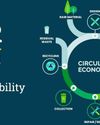WET SPINNING
Textile Value Chain
|July 2020
Highlight of the article:Wet spinning is the oldest process.- It is used for fiber-forming substances that have been dissolved in a solvent.- The spinnerets are submerged in a chemical bath and as the filaments emerge they precipitate from solution and solidify.- It is called “Wet spinning” since the solution is extruded directly into the precipitating liquid.- Examples: Rayon, Aramid, Acrylic, etc.

The first monetarily effective strategy for the production of synthetic fiber was the wet turning of the cellulosic fiber, rayon. This technique is as yet utilized today. Basically, the procedure includes the utilization of a proper fluid arrangement, which is siphoned through a little spout, which is known as a spinneret, into a synthetic shower that coagulates the expelled arrangement of unlimited strands of fibers. These coagulated persistent filaments are drawn out of the shower, cleansed by washing, dried and afterward twisted onto spools. The development of the spinneret might be shifted by the ideal outcomes. On the offchance that the spinneret has one expulsion gap, at that point a monofilament yarn will be created. In the event that the spinneret has numerous gaps, at that point a multifilament yarn will be created. The size and number of the openings of spinneret might be fluctuated. In this manner, the number and size of the fibers of which it is developed decide the thickness, or denier of the yarn. Likewise, the measure of turn given the prepared yarn will influence its surface and quality.
On the offchance that we talk in detail, Wet turning is the most mind boggling of the turning procedures. Some wet turning forms require the polymer answer for be kept above or beneath surrounding temperature and subsequently a warmth exchanger is utilized. The spinnerets are drenched in tanks containing the coagulation into which the fibers are expelled. The expulsion course is variable from vertically upwards to flat. The spinnerets utilized in wet-turning can have up to 2,000 gaps for business applications. In any case, ordinary wet turning is the slowest of the chief procedures having windup rates to roughly 150 m/min.
Cette histoire est tirée de l'édition July 2020 de Textile Value Chain.
Abonnez-vous à Magzter GOLD pour accéder à des milliers d'histoires premium sélectionnées et à plus de 9 000 magazines et journaux.
Déjà abonné ? Se connecter
PLUS D'HISTOIRES DE Textile Value Chain

Textile Value Chain
EPR in Textiles: Turning Compliance into Opportunity
When the EU Comes to Panipat, It Means One Thing — The World Is Watching
3 mins
November 2025

Textile Value Chain
European Parliament Delegation Visits Panipat Recycling Cluster to Strengthen India-EU Collaboration on Circular Textiles
A high-level delegation from the European Parliament's Committee on International Trade (INTA) visited the Panipat Textile Recycling Cluster — India's largest hub for recycled textiles and circular manufacturing — during their official visit to India.
1 mins
November 2025

Textile Value Chain
Paramount Instruments: Where Innovation Turns Testing into Joy
At Paramount Instruments, innovation isn't just a Pursuit- it's in our DNA.
2 mins
November 2025
Textile Value Chain
Crafting the Future: LMW & Hami Weavelon pioneer Compact Spinning in Polyester
Manmade fibres today form the backbone of the global textile industry, driven by their versatility, performance, and ability to meet the rising demand for both everyday and specialised applications.
3 mins
November 2025

Textile Value Chain
Data is the New Thread: Weaving India's Textile Sector into a Circular Powerhouse
On November 13, 2025, at the 12th Edition of the India and Sustainability Standards (ISS) International Dialogue and Conference held at Bharat Mandapam in New Delhi, representatives from the Home Exporters Welfare Association of India (HEWA) joined industry leaders, policymakers, and international organizations to address a pressing question: How can India's textile sector meet emerging global data requirements while supporting its MSME backbone?
3 mins
November 2025

Textile Value Chain
Rieter Winding Suction Nozzle Upgrade: More Yarn, Less Energy Use
After upgrading the suction nozzles on their 32 winding machines, Sanyang Textile Co., Ltd., China, saw an increase in yarn production of 3% and a reduction of 13% in energy use. The flow-optimised, aerodynamically designed suction nozzle enables efficient upper yarn search and pickup from the package. This results in a 55% reduction in red light percentage and a significant reduction in the operator's workload.
1 mins
November 2025

Textile Value Chain
EU's Extended Producer Responsibility (EPR) Law and Its Implications for India's Textile Industry
The European Union (EU) has approved a new Extended Producer Responsibility (EPR) framework for textiles. This is a major regulatory shift that makes fashion brands and producers accountable for their products' entire lifecycle, from design and production through collection, sorting, recycling and disposal.
9 mins
November 2025

Textile Value Chain
GTE Ahmedabad 2025 Concludes Day 3 with a Huge Footfall
The 38th Garment Technology Expo (GTE) Ahmedabad 2025, co-located with the Lace & Trims Show, wrapped up its third day on an impressive note, recording around 9,700 B2B visitors. The strong industry turnout reaffirmed the expo's role as one of the most influential and business-driven platforms for garment and apparel technology in the western region.
2 mins
November 2025

Textile Value Chain
Reinterpreting Korean Street Fashion through Sustainable Design Practices
A Path through Eco-conscious Urban Fashion
7 mins
November 2025

Textile Value Chain
3D Printing in Textiles Manufacturing: A Game-Changer in Design, Sustainability, and Efficiency
The global textile and apparel industry is undergoing a radical transformation due to the convergence of digital design, advanced material technology, and next-generation manufacturing. Of the latter, few have greater potential to change how textiles are made today than additive manufacturing, better known as 3D printing.
5 mins
November 2025
Translate
Change font size

